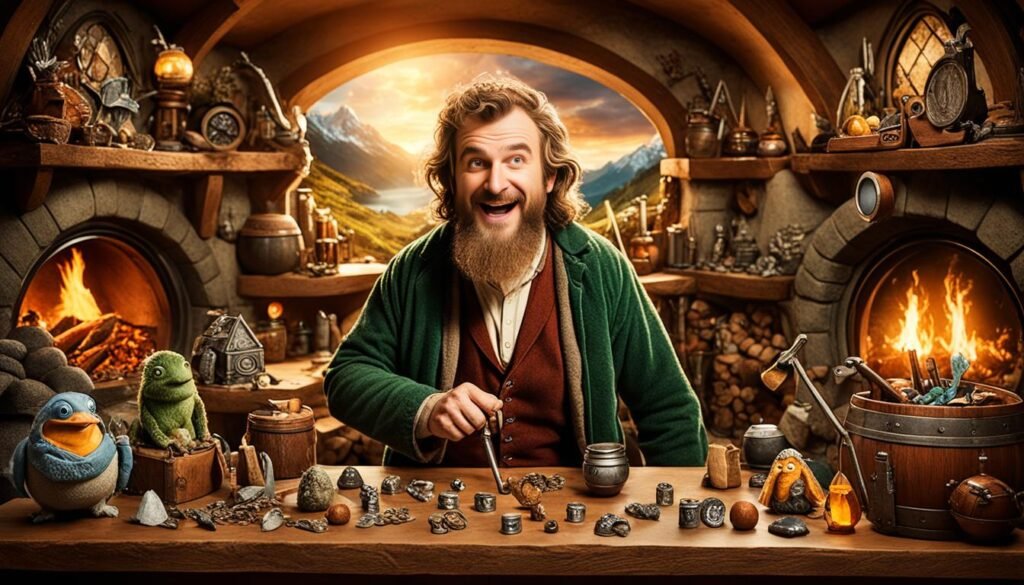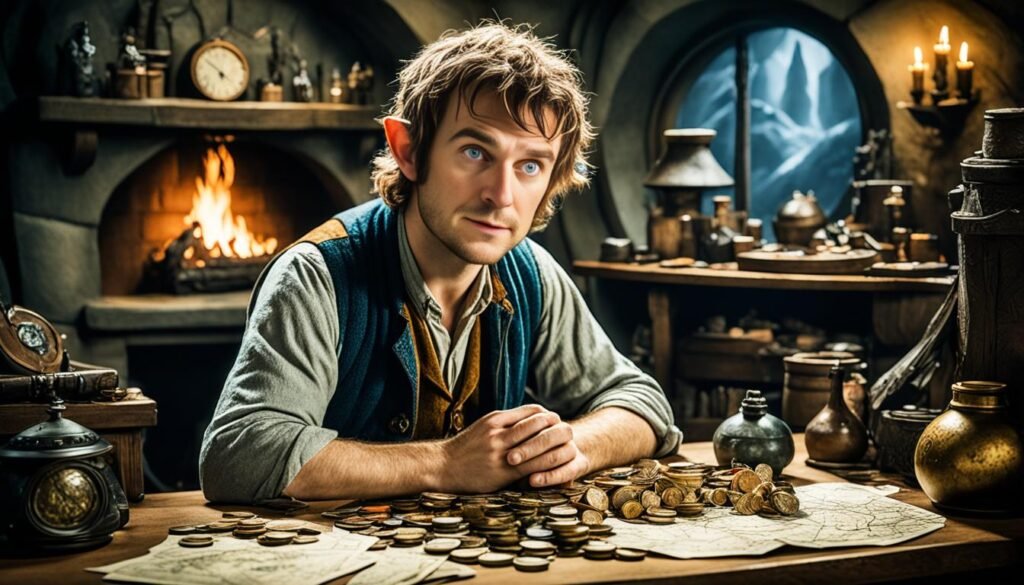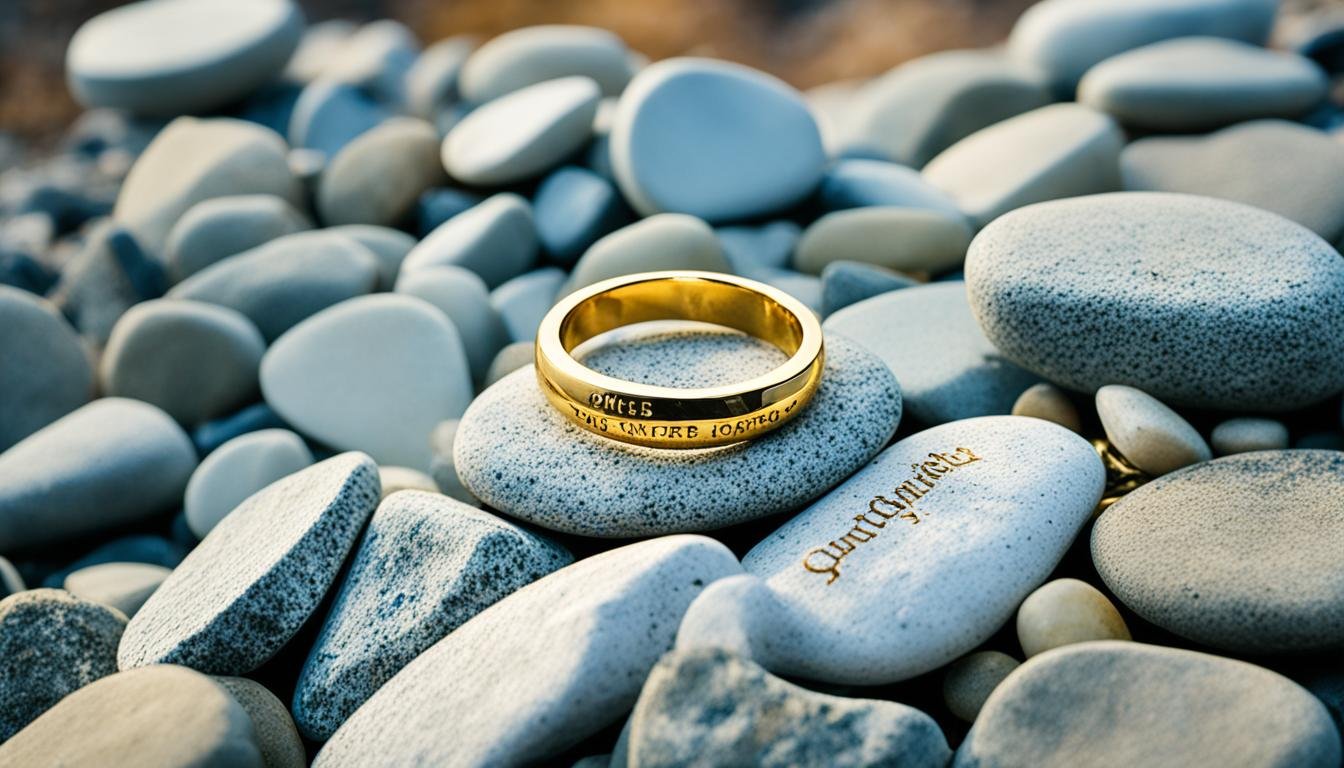In J.R.R. Tolkien’s renowned book, “The Hobbit,” there lies a pivotal scene known as the “Riddles in the Dark.” This intense contest of knowledge and reasoning takes place between the courageous Bilbo Baggins and the enigmatic Gollum, with high stakes hanging in the balance. In order to secure his escape from Gollum’s clutches, Bilbo must successfully solve five riddles posed by his cunning adversary. It is a test that will challenge even the savviest of Middle-earth enthusiasts.
The riddle game serves as a defining moment in the narrative, showcasing Bilbo’s wit and intellect as he navigates the treacherous encounter. Each riddle is carefully crafted by Gollum, filled with cryptic clues and thought-provoking wordplay. From mountains that never grow to invisible forces that fill empty holes, these riddles delve into the depths of Tolkien’s imaginative realm.
The riddle scene, often referred to as a masterpiece of storytelling, holds great significance in the broader context of Tolkien’s works and delivers enduring themes that resonate with readers. It is a testament to Bilbo’s resourcefulness and sets the stage for the epic adventures that await him and his companions throughout Middle-earth.
Table of Contents
ToggleKey Takeaways:
- The riddle game in “The Hobbit” is a contest between Bilbo Baggins and Gollum, with Bilbo’s life on the line.
- Gollum poses five riddles to Bilbo, each one requiring careful thought and deduction to solve.
- Bilbo’s winning question, “What have I got in my pocket?” catches Gollum off-guard and helps him escape.
- The riddle scene demonstrates Bilbo’s quick thinking, introduces the significance of the magical Ring, and highlights the theme of mercy.
- The scene serves as a turning point in Bilbo’s journey and lays the foundation for the adventures that follow in Middle-earth.
The Riddles Posed by Gollum
Gollum poses five riddles to Bilbo during their game. Let’s take a closer look at each riddle and its answer:
Riddle 1:
What has roots that nobody sees,
Is taller than trees,
Up, up it goes,
And yet never grows?
The answer to the first riddle is mountain. Although mountains have roots beneath the earth’s surface, they are not visible to the naked eye. Their towering height makes them taller than trees, but they do not grow like plants do.
Riddle 2:
This thing, all things devours:
Birds, beasts, trees, and flowers;
Gnaws iron, bites steel;
Grinds hard stones to meal;
Slays king, ruins town,
And beats mountain down.
The second riddle describes the wind. Winds can be powerful and destructive, capable of eroding mountains, breaking branches, and wearing away stones. They seem to “devour” everything in their path.
Riddle 3:
A box without hinges, key, or lid,
Yet golden treasure inside is hid.
The third riddle refers to egg. An egg is a fragile container that holds a precious potential life within, symbolized by the “golden treasure” or the yolk inside.
Riddle 4:
Alive without breath,
As cold as death;
Never thirsty, ever drinking,
All in mail never clinking.
The fourth riddle describes a fish. Fishes, being aquatic creatures, live in water and “breathe” through their gills. They are cold to the touch, do not require water to quench their thirst, and their scales provide a protective covering like armor.
Riddle 5:
This thing all things devours:
Birds, beasts, trees, flowers;
Gnaws iron, bites steel;
Grinds hard stones to meal;
Slays king, ruins town,
And beats mountain down.
The fifth riddle, which is a repeat of the second riddle, once again refers to time. Time is seen as an unstoppable force that affects and eventually consumes all things, from the passing of living beings to the erosion of mountains.
Now that we’ve explored the riddles posed by Gollum, we can see the cleverness and symbolism embedded within them. These riddles not only challenge Bilbo’s intellect but also serve as metaphors for key elements in the Hobbit’s narrative.
Bilbo's Winning Question
After answering Gollum’s riddles correctly, Bilbo emerges victorious in the game of wit. However, instead of retaliating with another riddle, Bilbo poses a simple question that catches Gollum off-guard: “What have I got in my pocket?”
This unexpected question leaves Gollum perplexed and unable to come up with the right answer. Little does Gollum know that Bilbo conceals the all-powerful Ring in his pocket. This magic artifact allows its bearer to become invisible, granting Bilbo a clever advantage in escaping from Gollum’s clutches.
Bilbo's Winning Question and the Magical Ring
| Question | Answer | Result |
|---|---|---|
| “What have I got in my pocket?” | The Ring | Bilbo’s escape from Gollum |

Significance of the Riddle Scene
The riddle scene in The Hobbit holds immense significance within the story. It not only portrays Bilbo’s exceptional quick thinking and intelligence but also introduces a pivotal element that shapes the events of both The Hobbit and The Lord of the Rings trilogy â the magical Ring.
Bilbo’s ability to outsmart Gollum using his wit and riddle answers showcases his resourcefulness and adaptability in difficult situations. It highlights his growth from an ordinary hobbit to a heroic figure capable of surmounting challenges with his sharp intellect.
“My riddles are a form of stealthy warfare, where I seek to disarm my opponents with cunning and intellect rather than fear and bloodshed.” – J.R.R. Tolkien
Moreover, the riddle scene introduces the audience to the magical Ring, which becomes a crucial object throughout Tolkien’s Middle-earth tales. The Ring’s ability to grant invisibility grants Bilbo a means of escape and sets in motion a series of events that will affect the entire realm.
In addition to Bilbo’s triumph and the introduction of the Ring, the riddle scene encapsulates a recurring theme in the story â mercy and pity. When Bilbo has the opportunity to kill Gollum, he instead chooses to spare his life, demonstrating his compassion and empathy. This act of mercy has profound consequences as it sets the stage for the redemption and future development of Gollum’s character.
The riddle scene in The Hobbit not only serves as a thrilling moment but also provides deeper insights into the characters and themes of the story. It showcases Bilbo’s growth, introduces a key plot device, and explores the moral complexities of mercy and sacrifice. Tolkien’s mastery of storytelling shines through in this unforgettable scene.

| Significance | Description |
|---|---|
| Bilbo’s Intelligence | Highlights Bilbo’s quick thinking and intellect in solving Gollum’s riddles. |
| The Magical Ring | Introduces the Ring, a key object throughout The Hobbit and The Lord of the Rings trilogy. |
| Mercy and Pity | Explores the theme of mercy and showcases Bilbo’s compassionate choice. |
Conclusion
The riddle scene in The Hobbit is a thrilling and memorable moment that showcases Bilbo Baggins’ wit and intelligence. It serves as a test of his knowledge and reasoning, ultimately leading to his victory over the cunning Gollum. The five riddles posed by Gollum provide readers with both a challenging and enjoyable experience, adding depth and excitement to Tolkien’s epic tale.
This pivotal scene not only highlights Bilbo’s cleverness but also sets the stage for the rest of his journey and the incredible adventures that await him in Middle-earth. It introduces readers to the magical Ring, an object of great significance that plays a crucial role not only in The Hobbit but also in The Lord of the Rings trilogy.
Through this riddle game, Tolkien explores themes of mercy and pity, as Bilbo chooses not to harm Gollum when given the opportunity. This decision has far-reaching consequences in the larger story, emphasizing the power of compassion and the impact of our choices. Overall, the riddle scene in The Hobbit engages readers with its thought-provoking challenges and adds depth to the narrative.
FAQ
What is the significance of the riddle scene in The Hobbit?
The riddle scene in The Hobbit is significant for several reasons. Firstly, it showcases Bilbo’s quick thinking and intelligence, as he is able to outsmart Gollum with his riddle answers. Secondly, it introduces the magical Ring, which plays a crucial role in both The Hobbit and The Lord of the Rings trilogy. Lastly, the riddle scene highlights the theme of mercy and pity in the story, as Bilbo chooses not to kill Gollum when given the opportunity. This act of mercy has far-reaching consequences in the later events of the series.
What are the riddles posed by Gollum in The Hobbit?
Gollum poses five riddles to Bilbo during their game. The first riddle asks about something that has roots, is taller than trees, and never grows. The answer is “mountain.” The second riddle describes something that cries without a voice, flutters without wings, bites without teeth, and mutters without a mouth. The answer is “wind.” The third riddle describes something that cannot be seen, heard, felt, or smelt, and fills up empty holes. The answer is “dark.” The fourth riddle describes something that is alive without breath, drinks without being thirsty, and is covered in mail. The answer is “fish.” The fifth riddle describes something that devours everything in its path, from birds to stones. The answer is “time.”
What was Bilbo’s winning question in the riddle game?
After answering Gollum’s riddles correctly, Bilbo wins the game. However, instead of asking Gollum a riddle in return, he asks him the question “What have I got in my pocket?” This question catches Gollum off-guard and he is unable to answer correctly. It is revealed that Bilbo had the magical Ring, which grants its wearer invisibility, in his pocket. This clever trick allows Bilbo to escape from Gollum’s clutches.
Can you solve the hobbit riddles?
The riddles posed by Gollum in The Hobbit are challenging and require clever thinking. Try your luck and see if you can solve them!
Are the riddles from The Hobbit famous?
Yes, the riddles from The Hobbit, also known as the “Riddles in the Dark” scene, have become famous among fans of J.R.R. Tolkien’s works. They are widely recognized as a classic and thrilling moment in the book.

